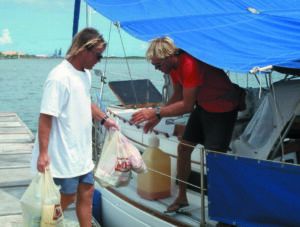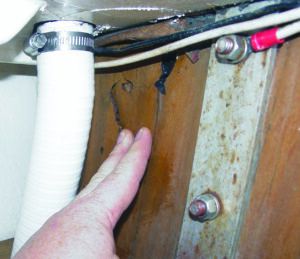MULTIHULL MADNESS
Regarding your report on the rising popularity of multihulls (see PS March 2017, “Multihull Madness”), when the wind speed doubles, the force and heeling moment on the sails quadruples. It does not go up by a factor of 100. Anyone with a knowledge of aerodynamics could confirm this. Secondly, while some multis do capsize by tipping sideways, they mostly go over because they dug a leeward bow into a wave, causing the bow to dig in and the boat to capsize diagonally. By design, this is really difficult to do with a modern cruising cat – especially on boats with a solid bridge deck between the bows. Finally, unless there is a really strong and sudden squall (e.g. a downdraft from a thunderstorm), there is lots of warning that a cruising multi is starting to get overpowered. While I would not say that you could not capsize a modern cruising cat, barring an unforseen thunderstorm squall, I think that you would have to work at it.
Rob Davidge
Endeavour Catamaran 30
Kingston, Ontario
Good point. We have made similar observations in a report on catamaran stability that explores in greater detail the impact that elements like hull shape and bridge-deck clearance have on performance and safety (see PS February 2021,“Multihull Capsize Risk Check).
UNDERWATER KINETICS LED FLASHLIGHT
With regards to your discussion on reports on LED flashlights (see PS December 2007, “Practical Sailor Sheds Some Light on LED Flashlights.”
I am an avid diver and instructor. I have had good experiences with Underwater Kinetics (UK) underwater lights. And I do a lot of night diving, often in excess of a hundred feet. I still have a few that work fine after 30 years of use. I just keep the o-rings lubed occasionally with silicon grease.
Fred Read
Tartan 37, Merry Dolphin
Oriental, North Carolina
EATING WEEVILS
Regarding your recent blog post “The Pesky Problem of Boat Pests,” I know that this may seem revolting to some people, but cooking and eating pasta and rice which contains weevils will (from my own experience—I’m not a doctor) do you no harm at all. You may not even notice them, other than as tiny dark specks. When living in an old 9 meter steel sloop in Brazil, we frequently found weevils in our pasta and rice supplies. My girlfriend/crew, whose father was a medical doctor, pointed out that they are only reformed proteins from the starches.

Before cooking, we picked out as many as we could bother to pick (not many), and ignored the rest. There were no discernible effects. So cook and crunch away happily! By the way, when we bought the boat in Brazil it was quite literally crawling with cockroaches, some as long as 5 cm. Sprays had no effect. Then we scattered piles of Boric acid powder in every dark corner. Magic ; after just one week, we never saw another cockroach.
You should be able to buy boric acid powder in any chemist/pharmacy, anywhere in the world.
Rob Neal
MGC-27
Norwich, England
We’re longtime fan of boric acid and borate-based cleaners such as Formula B (Homemade Mildew Preventers That Really Work, PS Blog May, 2018), in part because they are effective biocides, but also because bugs hate them. Thus a little boric acid in the pantry makes sense to us. The roaches do not eat it directly, but it does get on their legs, and when they clean themselves they die (see “PS August 2019, Giving Bugs the Big Goodbye”).
ROSEMARY OIL VS. SPIDERS
Regarding your “Pesky Pests” post, a solution of rosemary oil and vinegar can be applied to dock lines and other surfaces to discourage spiders. The herb does not harm them, but can keep them off. In the alternative, just teach the larger ones to roll tack.
C&C 41
National Yacht Club
Toronto, Canada
WATERPROOF EPOXY
I read with interest your report on hull damage and holes under water and waterproof epoxy. I wonder if a solution to an underwater hole could be found with NASCAR?
The idea came to me while watching the dreadful movie All Is Lost.
Routinely NASCAR has wrecks. Many times the sheet metal alone is damaged, but the car can still compete. Pit crews use a product called ISC X-Flex Racers Tape which comes as a roll and as a sheet 11” X 15” made of butyl rubber adhesive. The manufacturer claims it is waterproof, but I found no mention of it being able to be applied to a wet surface. It is slapped on by a pit crew member inside a 15 second pit stop.
Perhaps a test of available emergency repair pads such as this along with say Gorilla Tape which claims to be waterproof as well? Something like this might save a boat.
Norm Marshal
via PS Online
Sounds like a good project for us. Although we’ve not tested ISC Race Tape for this use, it did well in tests for chafe protection (see PS December 2020, “Chafe Tape Plan”).
STUCK BOLTS
Regarding your Inside PS blog post “More Boat Tips: Unsticking Stuck Nuts and Bolts,” Another trick for drilling out a fastener seized in a threaded bore , if it is broken above flush to the female threads, is to file or grind a perpendicular flat on the fastener and then carefully center punch the flat so the drill does not wander off-center and enlarge the bore. Starting with a smaller diameter pilot drill and then using a bigger drill, works well, too.
Drive-in style ‘easy-outs work well when the suggested ‘stud remover’ does not have enough fastener height to grip.
I noted that heat was not mentioned as another form of persuasion. Heating with a torch may damage or discolor anodizing, and will definitely destroy paint, as will a heat gun. To avoid harming surrounding surfaces, try heating the tip of a tightly fitting screwdriver, just shy of glowing red, and then insert it into the fastener’s slot or socket to transfer the heat. If a snapped fastener has been ground flat, press a heated flat faced punch against it. A few tries may be required, but this method has often saved the day and saved the paint.
Bruce Pfund
BP Special Projects
STUCK BOLTS II
Threadlocker (Loctite) not only keeps bolts from coming loose but also fills the space on the back side of the threads to prevent rust. An NCT bolt only has about 15 percent thread engagement leaving lots of space for moisture (rust). I use blue thread locker on everything I put together. For frozen nuts I have had lots of luck heating the nut red hot with an acetylene torch and immediately pouring cold water on the nut.
The thermal shock breaks the nut loose from the bolt and usually comes off easily. For small bolts that break off, drill completely through the bolt with a drill size that allows a bolt extractor to work. Heat the bolt and melt beeswax (from a sewing or craft store) against the hot bolt. The beeswax has a very low viscosity and works its way into the seized threads allowing easy removal of the broken bolt. I learned these tricks from working as a diesel mechanic for 45 years.
Robert Jacobs
Harrison Township, MI
Fall is a good time to tackle do-it-yourself projects and onboard maintenance or systems upgrades. It’s also when many of us will shop for that next “new” boat. Many 2021 boat shows are back on the schedule after being cancelled in 2020.
DO-IT-YOURSELFERS
Here are a few worth DIY projects tackling in the off-season. We detail building a simple winter boat cover frame in the September 2011 issue. For those with tired-looking decks, be sure to check out our reports on nonskid options for the do-it-yourselfer (PS November 2013); these include mats and paints. Have an electronics installation or rewiring project on tap? Get some pro tips for rewiring (PS July 2016). If you’re looking for a boatyard where you can actually do the work yourself while hauled out, you can find a rundown of DIY-friendly boat yards (PS June 2009), as well as a list of reader-recommended DIY yards in the Oct. 29, 2013 Inside Practical Sailor blog post. Other good cool-weather projects worth considering: fuel tank cleaning (blog post, June 6, 2018), sail cleaning (blog post, Dec. 6, 2016), making your own chafe guards (PS July 2011), and building your own dinghy wheels (blog post, August 15, 2017).
BOAT SHOPPING?

In the market for a new-to-you boat? We highly recommend reading our checklist for DIY boat surveys (PS June 2012 online) and our “Sailor’s Guide to Marine Insurance” (PS October 2012 online). Cruisers should also be sure to check out the April 2009 issue’s look at cruising boats over 35 feet long and under $75,000, “Affordable Cruising Sailboats.” If you’re considering a boat that’s well-weathered (or possibly storm damaged), the January 10, 2017 blog, “Buyers Beware of Post-storm Bargains,” is also useful.
PS’S EXCLUSIVE EBOOKS
Our new three-volume water report will ensure that your crew will stay healthy and hydrated with clean, freshtasting water straight from your tanks. Volume One compares the most popular water filters on the marine market, and describes some cost-saving do-it-yourself options. In Volume Two you’ll learn secrets to ensuring that your water supply remains clean and good-tasting throughout your voyage. In Volume Three, you’ll see the results of our head-to-head testing of the major brands of watermakers sold today. Available at www.practical-sailor.com/products.
Regarding your report on classic centerboard trailer sailors featuring the Aquarius 23 (see PS November 2015 “Four Trailer-sailors and their Keel/Launch Problems”) I had an Aquarius 21 for thirteen years in San Diego. I sailed it all the time, and made four trips to Catalina Island in it. It had some poor construction flaws (like particle board coring for the deck), but it was inexpensive, and easily handled by one person. I loved it.
Kevin Cain
San Diego, CA


































